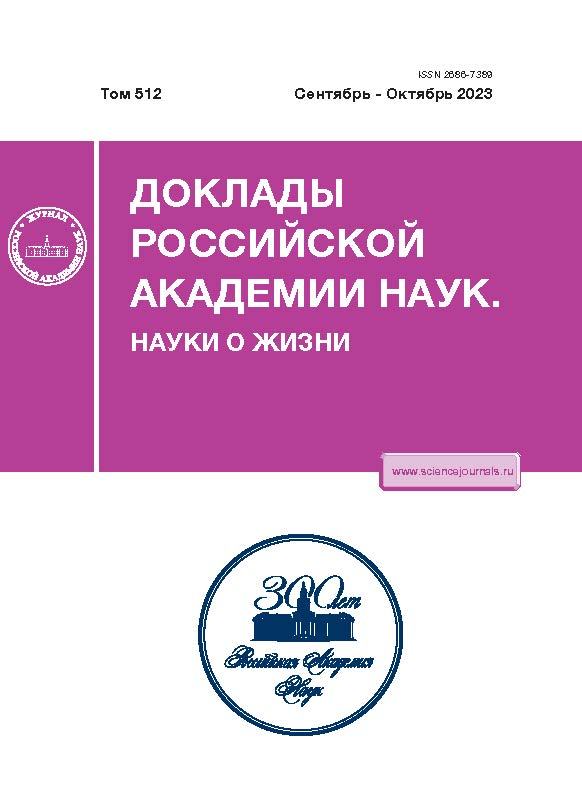ANTIDIABETIC EFFECT OF A NEW ORIGINAL NT-3 DIPEPTIDE MIMETIC
- Autores: Yagubova S.S.1, Chernyshevskaya M.A.1, Ostrovskaya R.U.1, Gudasheva T.A.1, Seredenin S.B.1
-
Afiliações:
- Federal State Budgetary Institution “Research Zakusov Institue of Pharmacology”
- Edição: Volume 512, Nº 1 (2023)
- Páginas: 417-421
- Seção: Articles
- URL: https://cardiosomatics.ru/2686-7389/article/view/651065
- DOI: https://doi.org/10.31857/S2686738923700336
- EDN: https://elibrary.ru/PUTHWA
- ID: 651065
Citar
Texto integral
Resumo
It was previously established that the original dipeptide mimetic of the 4th loop of NT-3, hexamethylenediamide bis-(N-monosuccinyl-L-asparaginyl-L-asparagine) (GTS-301), has a pronounced neuroprotective effect in vitro at concentrations of 10–5–10–12 М. In the present study, experiments on the streptozotocin-induced diabetes model in C57Bl/6 mice showed that GTS-301, administered intraperitoneally for 32 days at doses of 0.1 and 0.5 mg/kg, has antidiabetic activity manifested in the reduction of hyperglycemia, polydipsia, and in the increase of animal survival. The results obtained confirm the concept of the similarity of neurochemical mechanisms underlying the regulation of neurons and β-cells functions.
Palavras-chave
Sobre autores
S. Yagubova
Federal State Budgetary Institution “Research Zakusov Institue of Pharmacology”
Email: syagubova@yandex.com
Russian Federation, Moscow
M. Chernyshevskaya
Federal State Budgetary Institution “Research Zakusov Institue of Pharmacology”
Email: syagubova@yandex.com
Russian Federation, Moscow
R. Ostrovskaya
Federal State Budgetary Institution “Research Zakusov Institue of Pharmacology”
Email: syagubova@yandex.com
Russian Federation, Moscow
T. Gudasheva
Federal State Budgetary Institution “Research Zakusov Institue of Pharmacology”
Email: syagubova@yandex.com
Russian Federation, Moscow
S. Seredenin
Federal State Budgetary Institution “Research Zakusov Institue of Pharmacology”
Email: syagubova@yandex.com
Russian Federation, Moscow
Bibliografia
- Gudasheva T.A., Povarnina P.Y., Tarasiuk A.V., et al. Low-molecular mimetics of nerve growth factor and brain-derived neurotrophic factor: Design and pharmacological properties // Med Res Rev. 2021. V. 41. № 5. P. 2746–2774.
- Гудашева Т.А., Сазонова Н.М., Тарасюк А.В. и др. Первый дипептидный миметик нейротрофина-3: дизайн и фармакологические свойства // Доклады Российской Академии наук. Науки о жизни. 2022. Т. 505. С. 54–60.
- Островская Р.У., Ягубова С.С. Общие механизмы в патогенезе болезни Альцгеймера и диабета: пути фармакологической коррекции // Психиатрия. 2014. Т. 61. № 1. С. 35–43.
- Ostrovskaya R.U., Ivanov S.V. Neuroprotective Substances: Are they Able to Protect the Pancreatic Beta-Cells Too? // Endocrine, Metabolic & Immune Disorders – Drug Targets. 2022. V. 22. P. 834–841.
- Watcho P., Stavniichuk R., Tane P., et al. Evaluation of PMI-5011, an ethanolic extract of Artemisia dracunculus L., on peripheral neuropathy in streptozotocin-diabetic mice // Int J Mol Med. 2011. V. 27. № 3. P. 299–307.
- Hakim Z.S., Patel B.K., Goyal R.K. Effects of chronic ramipril treatment in streptozotocin-induced diabetic rats // Indian J Physiol Pharmacol. 1997. V. 41. № 4. P. 353–360.
- Katoh-Semba R., Kaisho Y., Shintani A., et al. Tissue distribution and immunocytochemical localization of neurotrophin-3 in the brain and peripheral tissues of rats // J Neurochem. 1996. V. 66. № 1. P. 330–337.
- Tazi A., Le Bras S., Lamghitnia H., et al. Neurotrophin-3 Increases Intracellular Calcium in a Rat Insulin-secreting Cell Line through Its Action on a Functional TrkC Receptor // J Biol Chem. 1996. V. 271. № 17. P. 10154–60.
- Ono M., Ichihara J., Nonomura T., et al. Brain-Derived Neurotrophic Factor Reduces Blood Glucose Level in Obese Diabetic Mice but Not in Normal Mice // Biochem Biophys Res Commun. 1997. V. 238. № 2. P. 633–637.
- El Ouaamari Y., Van den Bos J., Willekens B., et al. Neurotrophic Factors as Regenerative Therapy for Neurodegenerative Diseases: Current Status, Challenges and Future Perspectives // Int J Mol Sci. 2023. V. 24. № 4. P. 3866.
- Christianson J.A., Ryals J.M., Johnson M.S., et al. Neurotrophic modulation of myelinated cutaneous innervation and mechanical sensory loss in diabetic mice // Neuroscience. 2007. V. 145. № 1. P. 303–313.
- Akyol O., Sherchan P., Yilmaz G., et al. Neurotrophin-3 provides neuroprotection via TrkC receptor dependent pErk5 activation in a rat surgical brain injury model. // Exp Neurol. 2018. V. 307. P. 82–89.
- Donaghue I.E., Tator C.H., Shoichet M.S. Sustained delivery of bioactive neurotrophin-3 to the injured spinal cord. // Biomater Sci. 2015. V. 3. № 1. P. 65–72.
- Ji W.C., Li M., Jiang W.T., et al. Protective effect of brain-derived neurotrophic factor and neurotrophin-3 overexpression by adipose-derived stem cells combined with silk fibroin/chitosan scaffold in spinal cord injury. // Neurol Res. 2020. V. 42. № 5. P. 361–371.
- Sun X., Zhang C., Xu J., et al. Neurotrophin-3-Loaded Multichannel Nanofibrous Scaffolds Promoted Anti-Inflammation, Neuronal Differentiation, and Functional Recovery after Spinal Cord Injury. // ACS Biomater Sci Eng. 2020. V. 6. № 2. P. 1228–1238.
- Oudega M., Hao P., Shang J., et al. Validation study of neurotrophin-3-releasing chitosan facilitation of neural tissue generation in the severely injured adult rat spinal cord. // Exp Neurol. 2019. V. 312. P. 51–62.
Arquivos suplementares













